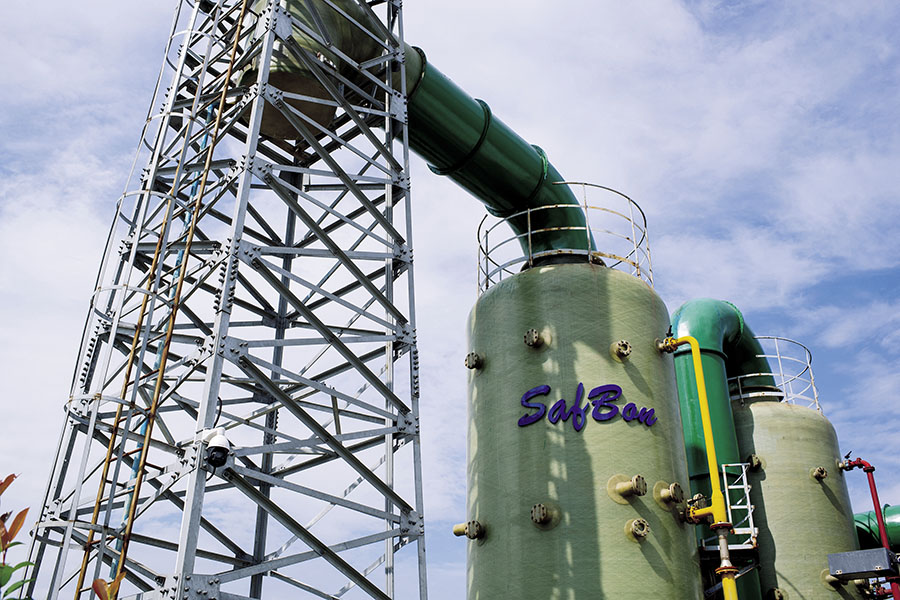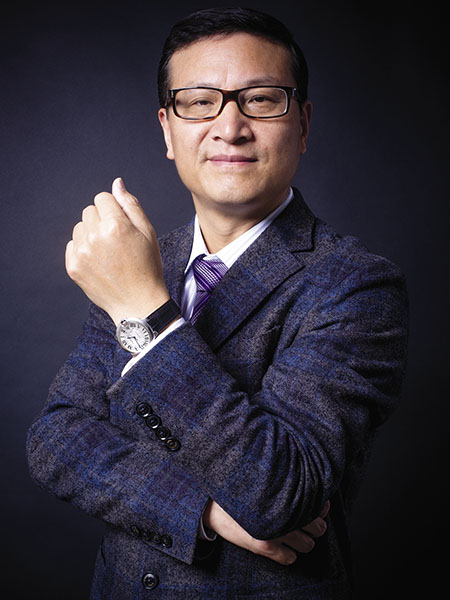
SafBon Water Service: An undisputed giant in China's burgeoning water industry
Zhang Chunlin gave up a prized state engineering job to hustle for a major chunk of the industry

The sweet smell of sludge: SafBon treatment plant outside of Shanghai
Image: Thierry Coulon for Forbes
The plant’s director, Shen Gengen, doesn’t hide his pride: “Our technology is unrivalled in the country. You can take a shower with water coming out of our plant.” You can’t even if you wanted to, though, as the water is sold for industrial use to generate more income.
“China’s [environmental] regulatory standards are rising,” says Zhang Chunlin, founder and chairman of the plant’s owner and designer SafBon Water Service, headquartered nearby. “It’s fuelling the sector’s growth and has brought us myriad opportunities.”
Zhang coined the name SafBon from ‘safe’ and ‘bon’—“Two of the best words from human languages,” as the fluent English speaker puts it. The company’s revenue surged by 52 percent last year to $151 million, earning a debut on the Best Under A Billion list, with household sewage accounting for 22 percent of the total. Water-supply services make up most of the rest. The 54-year-old holds 42 percent of SafBon’s $900 million market capitalisation.
China didn’t pursue urban water supply on a massive scale until around 1990. The late start in facilities and technology has led to a clear disparity with Western countries in water quality, says Zhang, while water availability is an issue in most of the nation’s parched north. Tightening environmental regulation is spurring domestic companies to bridge the tech gap, and Zhang is doing it with selective foreign acquisitions.
Last year, SafBon spent $38 million to buy Austria’s 67-year-old KWI, a global leader in liquid-solid separating technology, and this year, grabbed a treatment arm of Korean infrastructure group Doosan. With Chinese desalination needs being another expanding part of its business (20 percent at present), SafBon this February took a chunk of seawater specialist AquaSwiss. These moves have helped to make Zhang’s outfit China’s corporate leader in desalination technology, says Guo Shaojun of GEP Research, a Beijing environmental consulting firm.
China’s water treatment market saw a 13 percent rise to $31 billion last year and should keep that pace through 2020. But the overall sector is highly fragmented, with the biggest private player, Beijing OriginWater Technology, having only a 4 percent share last year. SafBon ranked 12th in the sector.

SafBon founder Zhang Chunlin, who is known as a “bold character”
SafBon has two Sponge City projects—out of the country’s 30 pilots so far—and is in talks for more. The one in Liupanshui, Guizhou, into which SafBon has pumped $235 million under public-private partnership, or PPP, will be fully onstream by year-end. Already last year, Sponge City work accounted for half of SafBon’s overall revenue.
Cautious about the PPP model, Zhang has kept it to 57 percent of SafBon’s total contracts. “Many companies are keen on PPP because of its big size. It shows up good on paper and suggests fast growth to investors, but [if over 70 percent] it could easily cause cash flow problems due to a longer payment cycle,” he avers.
Born to farmer parents on Shanghai’s fringe, Zhang took his high school teacher’s suggestion to attend central China’s Wuhan University to study the chemistry of thermal power plants. The major guaranteed a decent job in the days when China assigned each college graduate a tenured position.
Sure enough, Zhang returned to Shanghai in 1984 to join a state-owned water and power institute as an engineer. The job earned him $7,500 a year, when the national average was merely a few hundred dollars.
However, seeking more freedom and heartened by China’s then-leader Deng Xiaoping’s advocacy of economic reform and opening, Zhang quit the much coveted job and set up SafBon as a competitor in 1995, rounding up $70,000 in seed money from friends.
A wave of state sector veterans, especially technicians, left to start their own businesses within a few years of Deng’s 1992 speeches. “Some economists call us ‘the ’92ers’,” says Zhang. “We had been well trained inside the system, learning the practices and building our network, and this made it easier for us to succeed outside.”
SafBon didn’t land its first big deal for eight years—a $1.5 million contract with a thermal plant in Taiyuan, in northern China’s Shanxi Province. Unlike most of China’s thermal plants in the eastern or southern areas at the time, new ones inland required a filtering technology for dry conditions, which had been developed with the help of retired engineers from Zhang’s former employer.
“It was those old comrades that laid the tech foundation for our company,” he says, but it fell to Zhang to build trust in SafBon’s capability. Then Sars hit China in 2003.
“Most companies wouldn’t go on business meetings, and Taiyuan was a severely affected area. We talked to each other wearing masks,” Zhang remembers. “There were only two or three people on my flight there, and also only two or three people around when I was dining in my hotel.”
“He’s always been a bold character,” says the sewage-treatment director, Shen, who grew up with Zhang in the village outside urban Shanghai. “Even when we were kids, he dared to swim in waters no one else did.”
Such boldness put SafBon on track for more business in those inland areas, which today still brings two thirds of the company’s sales. In 2004, it stumbled into municipal water treatment by supplying reclaimed domestic water to the new inland thermal plants.
More doors have been opened since then, and Zhang took SafBon public on the Shenzhen Stock Exchange in 2011.
Last year, SafBon opened an office closer to Shanghai’s downtown area for corporate finance and strategic decisions, and Zhang has been splitting his 15-hour workdays between there and headquarters on the outskirts. “Of course, we are an engineering company, but any company in its later stages of development would rely more heavily on finance,” he says.
The separation also is intended to give more leeway to other executives at the headquarters. Zhang resigned as general manager in 2015, leaving day-to-day operations to staff. (Afterward, he took a month off to attend a rowing programme at the University of Cambridge for Chinese entrepreneurs, organised by real estate boss and rowing enthusiast Wang Shi. Zhang continues to make time for outdoor sports.)
With succession in mind, the founder aims at recruiting 100 managers over the next ten years in a company with 400 employees today.
He says: “Grooming the second gen is an idea worth exploring”—his two daughters both work in the chemical sector—“but it all comes down to whether they are the most capable for the job.”
An entrepreneurial spirit and engineering mindset would seem to be prime qualifications.
(This story appears in the 01 September, 2017 issue of Forbes India. To visit our Archives, click here.)
Post Your Comment














